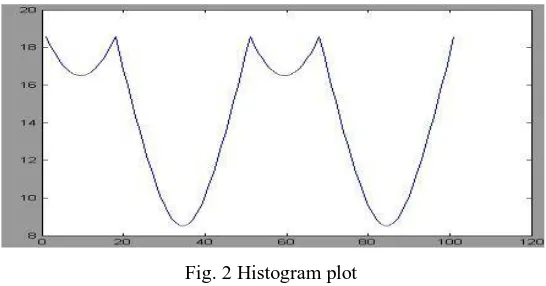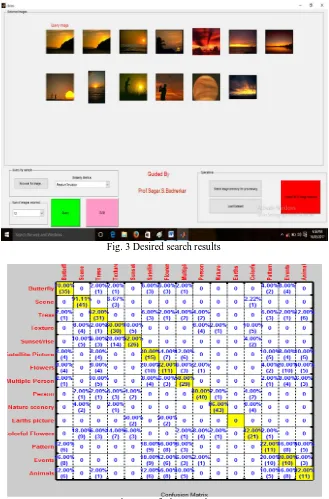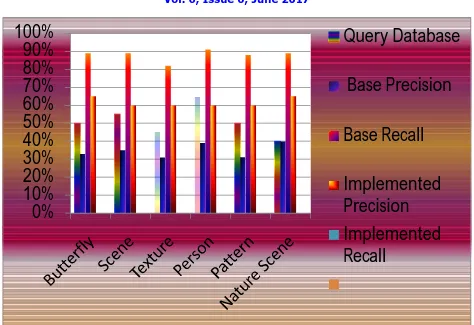An Effective Content Based Image Retrieval
Technique using Color and Texture Feature
N.R.Kharsan1, S.S.Badnerkar2
PG Student [EXTC], Dept. of EXTC, G. H. Raisoni College of Engineering and Management, Amravati.
Maharastra, India1
Assistant Professor, Dept. of EXTC,G. H. Raisoni College of Engineering and Management, Amravati.
Maharastra, India2
ABSTRACT: Content Based Image Retrieval (CBIR) is a developing trend in Digital Image Processing for searching and retrieving the query image from wide range of databases .An image is uniformly divided into 8 coarse partitions. The centroid of each partition is selected as its dominant color after the above coarse partition. By using Gray Level Co-occurrence Matrix (GLCM), texture of an image is obtained. Color and texture features are normalized. Using Gradient Vector Flow fields, shape information is captured in terms of edge images computed. To record the shape features, invariant moments are then used. A robust feature set for image retrieval is provided by using the combination of the color and texture features of an image in conjunction with the shape features. After the features are selected, an SVM classifier is trained to distinguish between relevant and irrelevant images accordingly.
KEYWORDS:Content based image retrieval, Color-correlogram, SVM classifier, Dominantcolor descriptor, Gray Level Co-occurrence Matrix, Gradient vector flow.
I.INTRODUCTION
Content-based image retrieval (CBIR) has become a prominent research topic. Therefore an important problem that needs to be addressed is fast retrieval of images from large databases. To find images that are perceptually similar to a query image, image retrieval systems attempt to search through a database. CBIR can greatly enhance the accuracy of the information being returned and is an important alternative and complement to traditional text-based image searching. For describing image content, color, texture and shape features have been used. Color is one of the most widely used low-level visual features and is invariant to image size and orientation. There are color histogram, colorcorrelogram, and dominant color descriptor (DCD) as conventional color features used in CBIR. Texture may describe the structural arrangement of a region and the relationship of the surrounding regions using gray-level co-occurrence matrix (GLCM). Shape feature has been extensively used for retrieval systems. CBIR system is based on Dominant color and GLCM texture and shape. In this process, visual contents such as shape descriptors and color features are extracted from each image of the database. The same is done for the user’s request in the form of a query image. Then, search engine is used for feature comparison in order to get the target images; that is, the images of the database that are most similar to the query one. The whole pipeline for CBIR can be roughly divided into three modules: Feature extraction module; Query module; Retrieval module. The first module includes techniques to convert an input image into a numerical array, normally called feature vector. Feature spaces usually are general composed by shape features, color, texture, histogram; edge features and image transform features. The query module takes the query image, performs its feature extraction and can provide resources to make modifications on the query images or even integration of image keywords into the query.
II.LITERATURE SURVEY
color moments, colorcorrelogram and Gabor texture features along with edge histogram descriptor. Further the results obtained are compared with CBIR system using SVM classifier. [1]
SonaliMathur, DeepaChaurse(2016), present an algorithm for web image search reranking approach introduces an online image search reranking approach that explores multiple modalities in an exceedingly graph-based learning theme. An information consists of various forms of pictures has enforced on the system completely different options like bar chart, color mean, Color structure descriptor texture is taken into thought for extracting similar pictures from the information.[2]
S. VanithaSivagami and K. Muneeswaran (2016) presented the tuning parameter for all the methods based on Bag of Visual Words is the size of the dictionary/code book, number of bins in the distribution. Due to the clustering process in the code book construction over a very large number of visual features, the number of over a very large number of visual features, the number of images considered in the Implemented work.[3]
R.Durga Prasad, B.V.K.Sai Kumar, K.Sai Ram, B.VeeraManoj (2016), proposes and demonstrates a fast algorithm for the purpose of image mining techniques is discovering meaningful correlations and formulations from previously collected image data. Image clustering and finding the minimum distance among the images provides better image. [4] Zhijie Zhao, Qin Tian, Huadong Sun, Xuesong Jin and JunxiGuo (2016) Implemented a new a novel approach for image retrieval by combining color, texture and shape features has been presented. The simulation results showed that our method did well on precision ratio,for scenes of query images are complex; the low visual features are insufficient to represent them. [5]
Other image retrieval algorithms based on CBIR were Implemented by Prof. Anil T. Lohar, Prof. Rahul Diwate(2016).Content could be color, shape, texture or any piece of information, which obtain from the image itself.. The concept of retrieving images based on their content is called as CBIR. The process of CBIR consists of three stages as follows: i. Image acquisition.ii. Feature Extraction.iii. Similarity Matching. Content Based Image Retrieval (CBIR) is different from the traditional database and text based image retrieval system. [6]
Neelima Bagri and Punit Kumar Johari (2016)Implemented a novel technique for images resize according to the region of interest for the faster retrieval of images. Deleting and removing complicated background will speed up further image processing. Very strong discriminative power feature makes an essential component in image and video retrieval. Therefore, it is very important to find an effective method to compute the directionality of an image, and tamura uses statistical measure to calculate statistical feature. And thus we extract texture features and shape and fused these feature vectors of tamura and shape combinations for better result. [7]
Ekta Gupta, Rajendra Singh Kushwah(2015) uses the visual contents of a picture like global features-color feature, shape feature, texture feature, and local features-spatial domain present to signify and index the image. CBIR method combines global and local features. In this paper worked on Haar Discrete Wavelet Transform (HDWT) for decaying an image into horizontal, vertical and diagonal region and Gray Level Co-occurrence Matrix (GLCM) for feature extraction. Support Vector Machine (SVM) used, different calculations to improve the exactness and execution of recovery. [8]
A widely used image retrieval method is the SVM developed byS.Sasikala,R. Soniya Gandhi (2015). A multi view approach was here presented to detect content Based Image Retrieval(CBIR) is a kind of Image Retrieval technique that could figure out images like sketch similar to querying images from image database. In Content Based Image Retrieval (CBIR) image can be retrieved by query known as Query by Image Content and also known as Content Based Visual Information (CBVI) which is the application of Computer Vision techniques for the problem of searching digital images from large image database known as image retrieval problem.[9]
Miss.Aboli W. Hole, Prof Prabhakar L. Ramteke (2015), Implemented fast image retrieval algorithm content based image retrieval (CBIR) has become a prominent research topic. This motivates the extensive research into image retrieval systems. [10]
III. IMPLEMENTED METHODOLOGY AND DISCUSSION
Fig. 1 Block diagram of Content Base Image Retrieval
"Content-based" means that the search analyzes the contents of the image rather than the metadata such as keywords, tags, or descriptions associated with the image. The term "content" in this context might refer to colors, shapes, textures, or any other information that can be derived from the image itself. CBIR is desirable because searches that rely purely on metadata are dependent on annotation quality and completeness. Having humans manually annotate images by entering keywords or metadata in a large database can be time consuming and may not capture the keywords desired to describe the image. The evaluation of the effectiveness of keyword image search is subjective and has not been well-defined. In the same regard, CBIR systems have similar challenges in defining success.
Classification of Content based image retrieval:Color based image retrieval systems are classified on the basis of type of approach used for the extraction purpose of colors from the image.Color Histogram, Global color histogram Local color histogram, Histogram of individual image , Gray level co-occurrence matrix ,Color Dominant, Similarity Matching,RGB Color Model, HSV Color Mode, Color Conversion
Histogram of individual image:An image histogram is a type of histogram that acts as a graphical representation of the tonal distribution in a digital image. It plots the number of pixels for each tonal
value.
Fig. 2 Histogram plot
The horizontal axis of the graph represents the tonal variations, while the vertical axis represents the number of pixels in that particular tone. By looking at the histogram for a specific image a viewer will be able to judge the entire tonal distribution at a glance
Similarity Matching
The similarity matching stage is the main decision making stage of CBIR system and uses the features extracted in the previous stage to identify the image.
Precision = Number of Relevant Images Retrieved r Total Number of images retrieved n
Feature Extraction color and texture
Image Feature Matching Features Retrieved Images
Query Image
Recall = Number of Relevant Images Retrieved _ r_ Total Number of relevant images in database m
IV. RESULT AND DISCUSSION Obtained results and its Confusion Matrix is shown below
Fig. 3 Desired search results
Fig 3 indicates that desired image is obtained by searching for query image as more accurately and the Confusion matrix is shown in fig 4 indicates that the image belongs to scene with 91.11 % results.
SVM Average Accuracy and Recall Rate :
Table 1 Average Accuracy (83 to 92%) using six different SVM Matrix.
SVM Metrics Butterfly Scene Nature's Scene Texture Person Pattern
L1 88.89% 88.89% 82% 91.11% 88% 88.89% L2 91.11% 88.89% 88.89% 88.89% 88.89% 88.89%
Chebychev 88.89% 91.11% 88.89% 82.22% 91.11% 91.11%
Relative Deviation 88.89% 91.11% 86% 88.89% 88.89% 88.89%
Minkowshiv 88.89% 88.89% 91.11% 91.11% 91.11% 88.89%
Fig. 5 Average Accuracy using six different SVM Matrix.
Table 2 Comparison of Based paper and Implemented system for Retrieved Accuracy and Recall Rate of (60 to 65%) using six different class.
Query Database Base Precision Base Recall
Implemented Precision
Implemented Recall
Butterfly 50% 33% 88.89% 65.00%
Scene 55% 35% 88.89% 60.00%
Texture 45% 31% 82% 60.00%
Person 64.50% 39% 91.11% 60.00%
Pattern 50% 31.12% 88% 60.00%
Nature Scene 40% 40% 88.89% 65.00%
0.00% 10.00% 20.00% 30.00% 40.00% 50.00% 60.00% 70.00% 80.00% 90.00% 100.00%
L1
L2
Chebychev
Relative Deviation
Fig. 6Comparison of Based paper and Implementedsystem for Retrieved Accuracy and Recall Rate
.
Analysis of Implemented CBIR System:Database of 1400 images of 15 different classes is used to check the performance of the algorithm developed. In order to measure retrieval effectiveness for an image retrieval system, precision and recall values are used. Five different images of each category are used as query images, some representative sample images which are used as query images are shown in below fig. 5.For testing the performance of each Implemented CBIR technique, and 05 queries (1 from each category) are fired on the database of 1400 variable size generic images spread across categories. This is an efficient way of image retrieval system by combination of text, a color space approach with by feature extraction. Content-based image retrieval system was implemented and results were obtained. It was examined with the database .It is observed that the average accuracy percentages of (83 to 93%) for 6 randomly chosen images using different SVM metric algorithms in the 1400 images. Performance comparison of accuracy percentage of 6 randomly chosen images as queries using six different SVM Matrix for the Implemented CBIR techniques indicates that L1 Matrix will provide satisfied results as compared to the other SVM Matrix.
In the Implemented system, super vector machine Matrix ie L1 give better results when compared with other distance metrics. The overall accuracy percentage was between 83% - 93 %.
VI.CONCLUSION
This project indicates a Content Based Image Retrieval (CBIR) system which is used to overcome the problem of textual approach using visual features of an image. It establishes an efficient combination of color, shape and texture features. Here the Butterfly, Pattern, Person, Natures Scene and Scene images are given as dataset. The images in database are loaded. The resultant image is given as input to feature extraction technique which is transformation of input image into a set of features such as color, texture and shape. These features are combined effectively so that the retrieval accuracy and recall rate is enhanced. The classification technique such as Support Vector Machine (SVM) is
0%
10%
20%
30%
40%
50%
60%
70%
80%
90%
100%
Query Database
Base Precision
Base Recall
used to classify the features of a query image by splitting the group such as color, shape and texture. Finally, the relevant images are retrieved from the database. Accuracy and error rate are found to be precise. This method gives much better performance than the traditional method of image retrieval. Investigation of more effective color, shape and texture feature extraction methods is required to improve the robustness of the system by increasing the number of categories in the database. The Implemented CBIR system will help the more number of researchers to search for similar images more accurately to that of query image.
REFERENCES
[1] Vikhar P., Karde P., “Improved CBIR System using Edge Histogram Descriptor (EHD) and Support Vector Machine (SVM)” ,IEEE Conference, pp.5090-5095, 2016.
[2] SivagamiS V, Muneeswaran K,“Image Object Retrieval Using Distribution of Mixed Shape Descriptors”, Middle-East Journalof Scientific Research, pp. 1057-1062,April. 2016..
[3] Prasad R D,K.Sai KumarB.V., K.Sai Ram, Manoj B.V., “Content Based Image Retrieval Using Dominant color and Texture Feature ” ,InternationaJournal for Modern Trends in Science and Technology,Vol. 2,Issue 4,pp. 36-41, April. 2016.
[4] Zhao Z.,Tian Q.,Sun H, Jin X.,Guo J., “Content Based Image Retrieval Scheme using Color, Texture and Shape Features” ,International Journal of Signal Processing, Vol. 9, pp. 203-212, 2016.
[5] Lohar A. T.,Diwate R., “Augmented Performance Analysis of Block Truncation Coding based Image Retrieval techniques through sundry similarity measures”International Journal of Research in Engineering,Science and Technologies, Vol. 6, pp. 65-73,March 2016.
[6] Sasikala S.,Gandhi R. S., “Efficient Content Based Image Retrieval System with Metadata Processing”International Journal for Innovative Research in Science and Technology, Vol. 1, Issue 10, pp. 72-77,March 2016.
[7] Mathur S.,Chaurse D., “Rank Based Image Retrieval Technique using Hue Saturation and Value and Gray Level Co-occurrence MatrixFeatures,”International Journalof Researchand Scientific Innovation, Vol. 3, Issue 1A,pp. 47–52, Jan. 2016.
[8] Gupta E., SinghK.R., “Combination of Global and Local Features using DWT with SVM for CBIR”IEEE Conference, pp. 281-28 , 2015. [9] Bagri N., Johari P.K., “A Comparative Study on Feature Extraction using Texture and Shape for Content Based Image Retrieval”
International Journal of Applied Science and Technolog,, Vol. 80, pp. 41–52,2015.


